
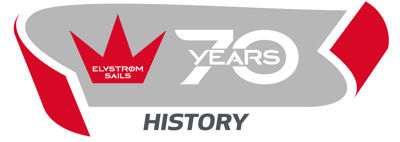
2024 is an important year in the story of Elvstrøm Sails as we mark our 70th anniversary – and this is obviously also a great occasion to look back at the history of Elvstrøm Sails and of course our founder, Paul Elvstrøm.
For Paul Elvstrøm, growing up at the seaside near Copenhagen became the start of a lifelong passion for sailing - and eventually it became the spark that lit everything for a legendary career. He founded his incredible career in sailing long before turning his ideas into products and forming what became the Elvstrøm Sails of today. Paul Elvstrøm always had a unique blend of ingenuity and flair for the sport – all at once being a great ambassador for making sportsmanship an integral part of sailing.
Paul was born on February 25, 1928 in Hellerup just north of Copenhagen. The location of the family home became the starting point for everything that followed. Situated near the coastline, the close access to Øresund played its central part in attracting Paul Elvstrøm to sailing, and while he joined the local sailing club, Hellerup Sejlklub, at 10 years of age, it later also became the headquarters for the very first iteration of Elvström Dinghy Sails.

Innovating in and outside the sport
Through his teenage years, Elvstrøm had a strong training regime and raced as much as he could get to. It was also the time where the innovative nature of Paul Elvstrøm started to shine - and as he managed to get his first qualifier for the Olympics, he got to a point where he found himself having a weight-related disadvantage.
As the heavier competitors seemed to have an advantage up through the 30’s, 40's and 50's in dinghy racing, Paul Elvstrøm found himself having a less than ideal stature for the racing given that he was some 20-30 kilos lighter than the competition.
This was the time where he practiced and started to master the technique, which soon became the standard. This was the hanging technique, and by hanging off the side of the dinghy rather than sitting on it, he re-gained the advantage he didn’t have initially.
He really set to work on this technique after winning his first Olympic gold in 1948, and the technique soon turned out to be an important aspect in maximizing the potential of the Finn. The Finn was a very demanding type of dinghy, and here the combination of weight and placing it correctly became crucial.
Mastering the technique soon meant that the ideal sailor had just the shape of Paul Elvstrøm, and as time progressed from his initial Olympic win at the age of 18 in London in 1948, the Finn was introduced ahead of the 1952 Olympics in Helsinki. Paul Elvstrøm really got to grips with the new class of dinghies, and through the following eight years he dominated the Finn class. It led to three Olympic titles in a row plus two world titles and one European title.
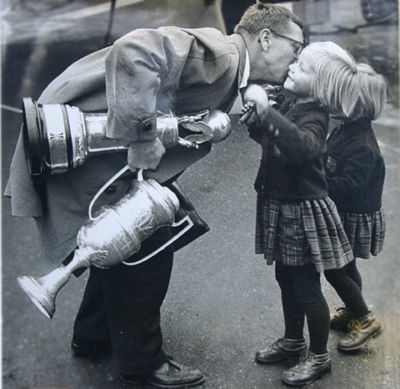
The new business venture
Through the peak of Elvstrøm’s Olympic career, a new business venture started to take shape. In 1953, Paul Elvstrøm and his good friend Erik ‘Strit’ Johansen set to work on their own sails for dinghy racing. They found a number of places in which to improve design and production at once. The first step was to optimize a sewing machine for the job, second was to create a tool to draw parallel lines on the sailcloth.
This tool made them able to get perfect lines - and to ensure that the folds and seams were totally precise every time. The duo found a good solution, and while their choice of cloth was more a matter of luck than initial knowledge, they soon realized they had found a good recipe. (Paul Elvstrøm Fortæller, Creagh-Osborne / Carlsen, 1987; 34)

For their first productions, the duo aimed at the German-invented Pirate dinghy, which soon turned out to be a success. ‘Strit’ Johansen was an avid sailor in the Snipes at the time, so the next stop was the Snipe class, in which the sails from Elvström Dinghy Sails also became the next big thing.
The initial success soon catered for more, and as 1953 turned into 1954, Elvstrøm prepared a small factory in the basement under the family villa in Hellerup. The production grew rapidly to form the Elvstrøm Sails of today - a story which we have previously covered here. (Paul Elvstrøm Fortæller, Creagh-Osborne / Carlsen, 1987; 35-37)
While the new business was booming, Paul Elvstrøm became busier than ever. Up until his new business venture, he was a successful building contractor, but he soon swapped bricklaying for sailmaking. And in the sport, his career was hitting new highs every year. The Olympic Gold from 1952 was backed up with another gold in the Finn class in 1956 and later also in 1960, while Elvstrøm added two 505 World titles in 1957 and 1958 plus two Finn World titles in 1959 and 1960 to his already impressive tally.

Breaking records
This was the start and continuation of a truly remarkable career in sailing. With four gold medals at four consecutive Olympic Games, Paul Elvstrøm made history and broke records in an era which became unique. Only one sailor has since improved on Elvstrøm’s olympic record as Ben Ainslie won four gold medals and then took a fifth medal at the Olympics, but adding to the outstanding records of Paul Elvstrøm is an outstanding run of world titles.
To this day, Paul Elvstrøm is still the only sailor ever to manage winning world titles in a total of seven different classes as he won the 505, Snipe, Finn, Flying Dutchman, Star, Soling, Half Ton. All in all, he won a total of 13 world championship titles.
Uniting the tasks of running an ever growing business alongside racing did however put lots of pressure on the shoulders of Paul Elvstrøm. The nerves caught up with him in the middle of the races at the 1960 Olympics in Neaples. Elvstrøm fell ill the night before the finals and braved through it. He won the decider and the gold, but opted to not start the final race due to his condition. (Paul Elvstrøm Fortæller, Creagh-Osborne / Carlsen, 1987; 58-60)
It led to Elvstrøm taking a break from competitive sailing after the Olympics - and except one outing in the Flying Dutchman Worlds in 1962, in which Paul Elvstrøm won with Hans Fogh, he was basically out of competitive sailing for a couple of years.
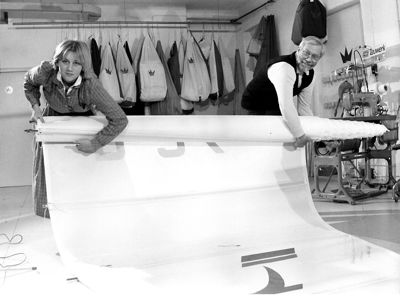
Taking a break - and making a comeback
The Danish Sailing Union entered Paul Elvstrøm as a reserve for the 1964 Olympics in Japan. Elvstrøm actually never really knew what class he was supposed to be the reserve in, but more importantly, coming back to the Olympics rekindled his passion for competitive sailing.
This also meant that Paul Elvstrøm was ready for a competitive comeback, and whilst he didn’t win any more Olympic medals, hence finishing 4th in Starboat and Tornado at the 1968 and 1984 games, respectively, he had plenty of success on the world and European stages.
Elvstrøm adapted in a great way to the Starboat and later found lots of success when the Soling was introduced. In 1966 and 1967, he won the Star Worlds twice in a row, and followed up with World titles in Soling in ‘69 and ‘74 plus winning the European titles in 1970 and 1971.
In terms of the company life, the World economy did in general endure a rough spell through the early 70's, and so did sailmaking. Elvstrøm kept the company going through until he eventually sold his majority stake in the company by 1976.
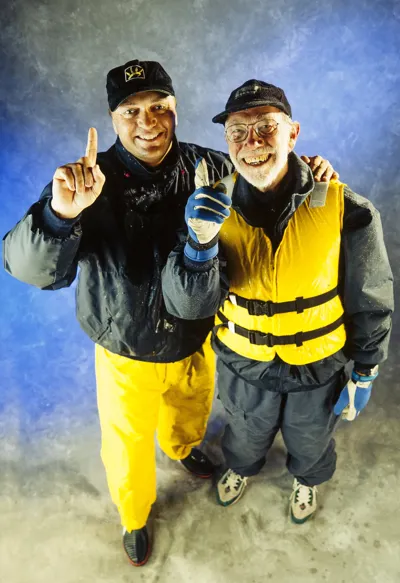
The father-daughter duo
Selling up also meant that Paul Elvstrøm could enjoy racing in a different way. Switching from keelboats to the multihulled Tornado was one of the big jumps in this period, and it ended up being the start of a successful duo as Paul Elvstrøm and his daughter Trine started sailing together.
At first, they sailed for fun, but as they gained mileage in the Tornado, they found out they were a fantastic match for the boat type.
They bought a completely new Tornado from the German yard, Glass, and took this boat to the european title in 1983. The year after, they managed the feat once again, also qualifying for the Olympics in Los Angeles in 1984. (Paul Elvstrøm Fortæller, Creagh-Osborne / Carlsen, 1987; 166)
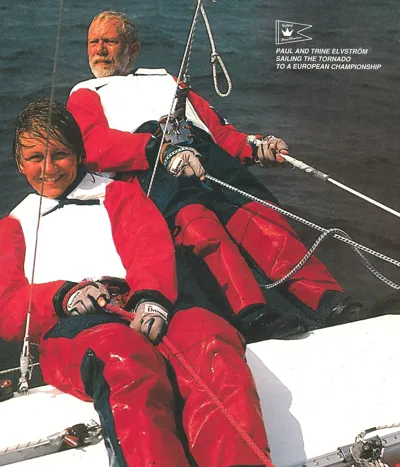
They raced well, but lost out on bronze by the tightest of margins - plus being struck with illness in the middle of the campaign didn’t help Trine. They ended up finishing 4th in total. Paul and Trine continued racing the Tornado and also raced at the Olympics in 1988 which became Paul’s last olympic participation, 40 years on from his stellar 1948 debut.
Throughout his illustrious career, Elvstrøm amassed an impressive collection of titles and awards, including four Olympic gold medals and 13 world championships across multiple sailing disciplines. His impact on the sport cannot be overstated, leaving an enduring legacy that continues to shape competitive sailing to this day.
Paul Elvstrøm passed away on December 7, 2016, but his spirit lives on in the hearts and minds of sailors everywhere. He will forever be remembered as a true sailing icon, a pioneer, and a champion in every sense of the word.